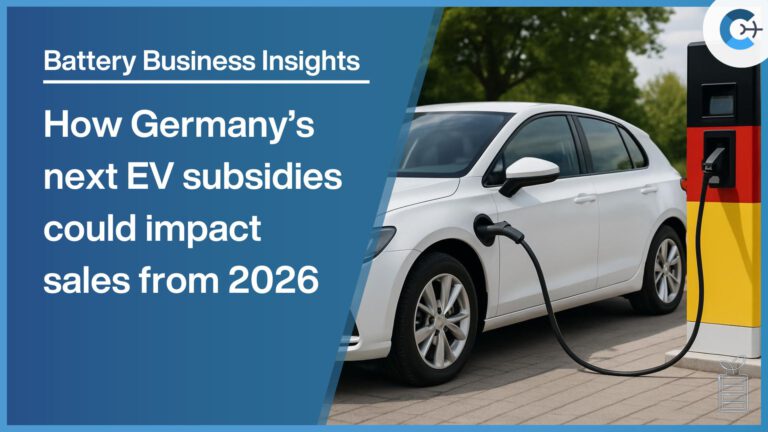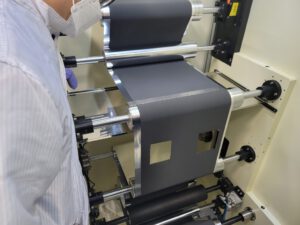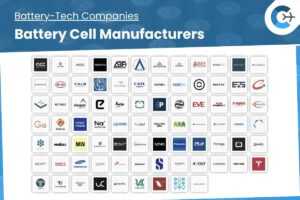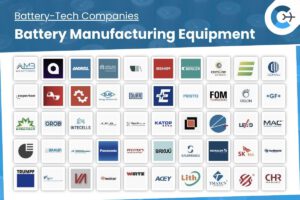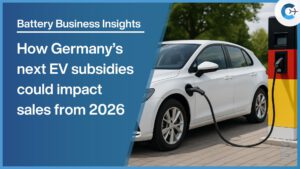Welcome back to this Battery Business Insights briefing on Germany’s new subsidy plan for electric cars. Policymakers are building a scheme aimed squarely at low- and middle‑income households, a segment left exposed after the national purchase bonus ended in late 2023. The coalition has set aside €3 billion and is weighing design details that will determine who qualifies, how support is delivered, and when it starts. For the market, the choices now will shape private EV demand, used‑EV liquidity, and manufacturer pricing strategies through 2029.
By the Numbers: What to watch
- €3 billion: Funding pool announced for 2026–2029.
- Up to €4,000: Reported potential purchase bonus per vehicle; not officially confirmed.
- ≥€3,000 + industry match: SPD proposal for 2026–2029 buyer’s premium.
- €45,000: Reported net list price cap for eligible BEVs.
- 2026 start: Reported start date if purchase‑grant model proceeds; SPD suggests leasing add‑on in 2027.
- 2.1 million EVs: Vehicles supported by Umweltbonus 2016–2023; ~€10 billion paid.
Background: From the abrupt end of Umweltbonus to a targeted relaunch
Germany’s Umweltbonus paid out roughly €10 billion to support about 2.1 million EVs from 2016 to 2023, before applications closed on December 17, 2023 and the program was shut on January 1, 2024 due to budget constraints. The gap that followed slowed private demand and sharpened calls for a fairer design focused on households with tighter budgets. On October 9, 2025, the coalition agreed to allocate about €3 billion from existing climate and social funds to restart consumer support without adding to the federal deficit.
Where We Stand
The format is still being negotiated. Two paths are on the table: a direct purchase grant (a narrower successor to Umweltbonus) and a social leasing model inspired by France. SPD negotiators previously floated a three‑year lease around €99 per month to broaden access for cash‑constrained households.
Media reports this week point to a purchase bonus up to €4,000 per vehicle starting January 1, 2026, administered by BAFA, alongside stricter income limits and a €45,000 net list price cap for eligible cars. Only battery‑electric vehicles would qualify; plug‑in hybrids would not. Crucially, used EVs would be eligible for the first time—an important shift for affordability. The environment ministry has not confirmed the circulating figures and says negotiations are ongoing.
In parallel, an SPD parliamentary paper proposes a federal grant of at least €3,000 from 2026–2029, matched by manufacturers or dealers, with eligibility focused on low- and middle‑income buyers, vehicles priced ≤€45,000, and built in Europe. The paper also backs a social leasing track in 2027. EAFO reporting suggests commuters earning roughly €40,000–€60,000 could be covered, though final thresholds are not set.
Impact: What this means for buyers and car makers
A capped purchase bonus or social lease aimed at lower incomes would shift support toward households with higher price sensitivity. A €45,000 vehicle cap would concentrate demand among compact and lower‑mid‑segment BEVs, pressuring OEMs to sharpen sub‑€45,000 pricing and expand base trims with adequate range. Including used EVs should accelerate turnover of fleet returns and improve residual values, reducing dealers’ days‑to‑sale and supporting a healthier second‑hand pipeline.
If a European‑production condition is adopted, German and EU brands would likely benefit most, while Chinese entrants could face a disadvantage in subsidized segments. Persistent non‑monetary incentives—vehicle‑tax relief, BIK advantages, and accelerated depreciation—should complement any purchase or lease aid by improving total cost of ownership for both private users and fleets.
Supporting Details: Eligibility, administration, and how this differs from past incentives
- Who would qualify: Policymakers are discussing income‑based eligibility that covers socially disadvantaged households and many commuters in the €40,000–€60,000 gross annual band. The environment ministry has not confirmed specific thresholds; the SPD paper references “low to middle monthly income” without numeric caps. (Source: European Alternative Fuels Observatory October 10, 2025; Clean Energy Wire October 16, 2025; Electrive October 16, 2025)
- What form support may take: The coalition is still debating a purchase bonus (reports cite up to €4,000) versus social leasing. The SPD paper proposes at least €3,000 public funding per car, matched by industry, from 2026–2029, plus a leasing program in 2027. BAFA would likely handle applications, as before. (Source: Electrive October 13, 2025; Clean Energy Wire October 16, 2025; Electrive October 16, 2025)
- How this differs from Umweltbonus: The price cap would drop to €45,000 (from €65,000 previously), targeting mainstream models. Plug-in hybrids would be ineligible. For the first time, used EVs would be eligible—important for affordability and for easing the backlog of lease returns. (Source: Electrive October 13, 2025; Automotive News October 14, 2025; European Alternative Fuels Observatory October 10, 2025)
What’s Next
Expect a formal design after additional talks with industry and within the coalition. If the purchase‑grant route is chosen, January 1, 2026 is a plausible start, with BAFA relaunching an application portal. If a social leasing pillar is added, 2027 is a realistic timeline. Buyers should prepare by checking model pricing versus a €45,000 net cap and watching for OEM matching rebates that could pair with the public grant.
Final Take
Germany is set to reintroduce EV support in a more targeted form. Whether the final mix is a purchase grant, social leasing, or both, the scheme will likely center on income‑tested eligibility, a €45,000 vehicle price ceiling, and inclusion of used EVs—changes that could materially improve affordability for commuters and families while nudging automakers to sharpen pricing in the mainstream BEV segment.

